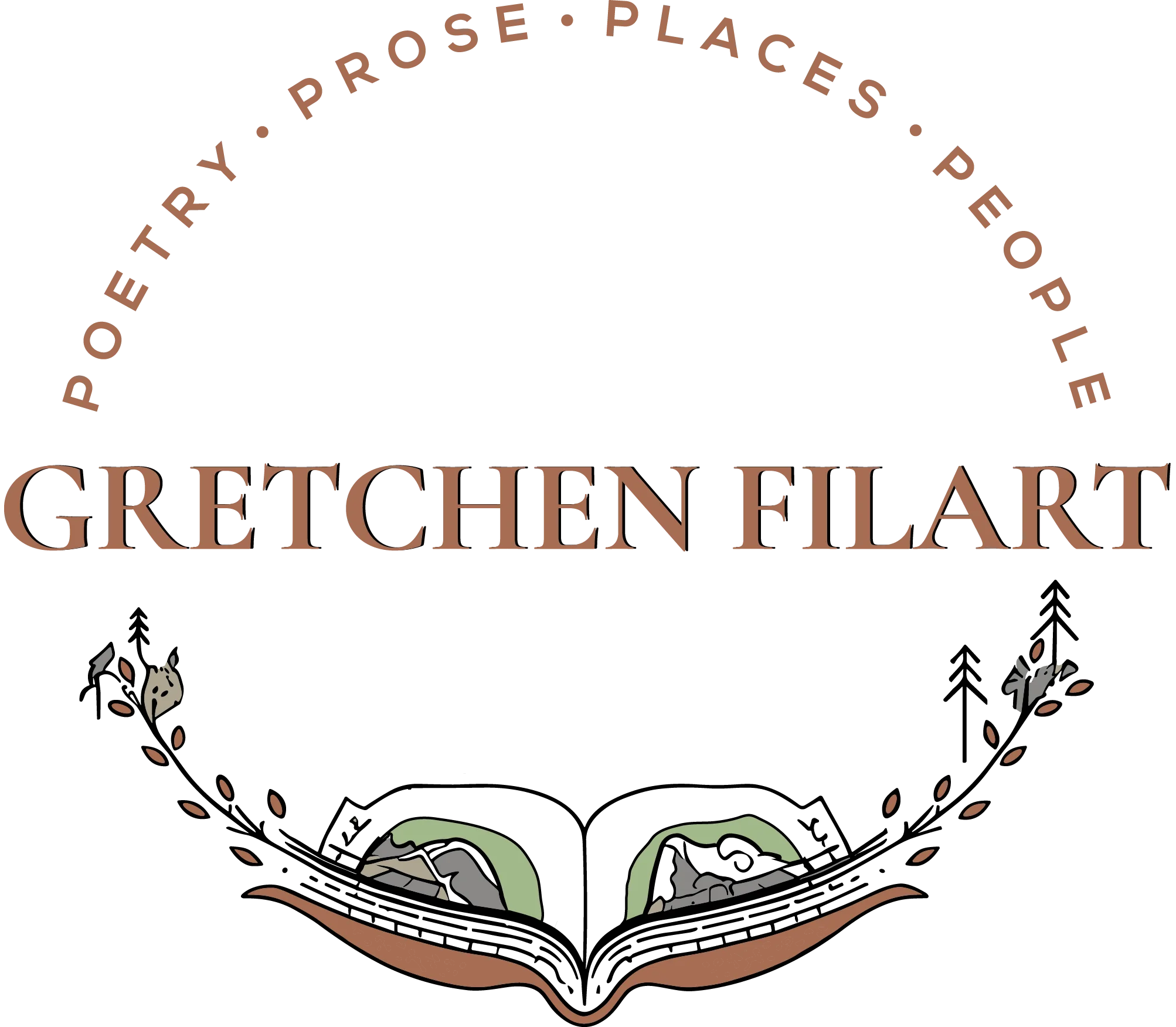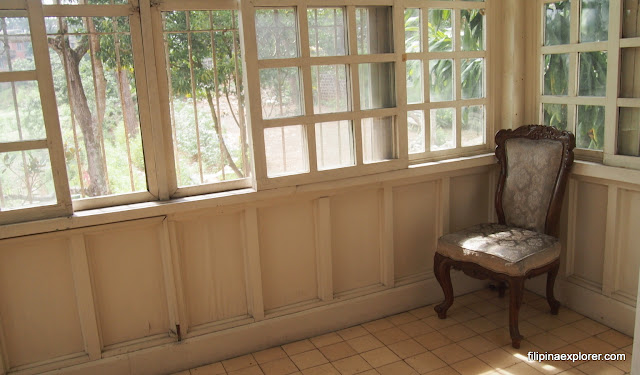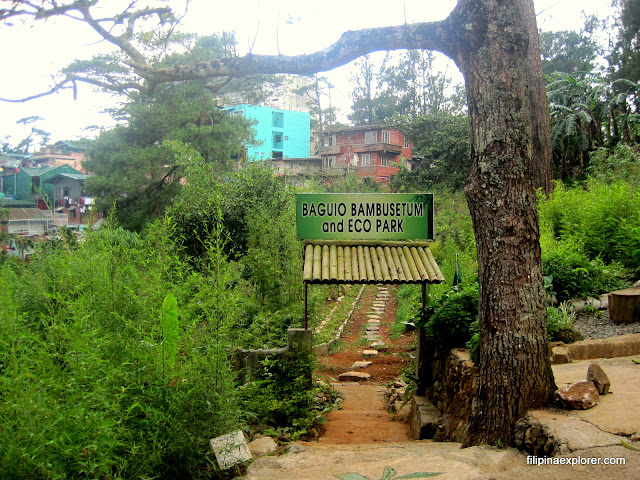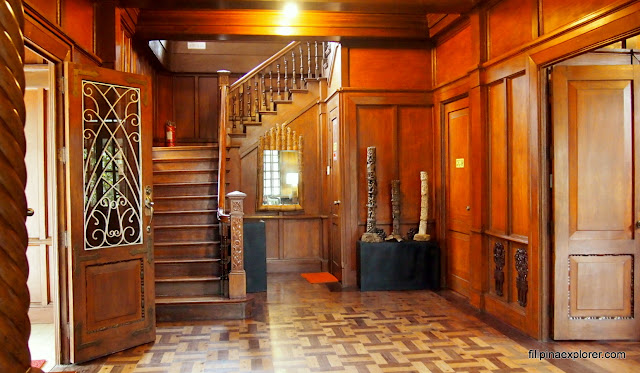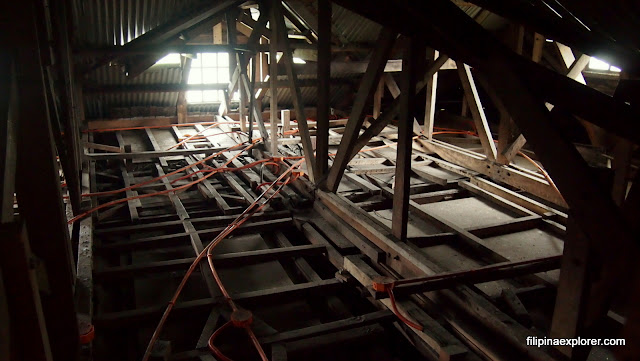A box full of Good Shepherd jams in hand, we stepped out to the open driveway along Leonard Wood Road. A welcome sign made of bamboo hangs by the entrance, as if beckoning, Come, the spirits await.
Voices – young, roused, and rowdy – echoed from the halls to the garage, once home to balut vendors and caretakers, and now a mini-gallery of bamboo carvings and a bamboo bike – all crafted by the Asin Bamboo Carvers Guild.
These are voices that belonged to the living: students on tour, a family of five. The sounds that ghosts reportedly make – footsteps, shutting of windows – are all but drowned in the noise of the present.
Suddenly, the Laperal White House isn’t as glum as I remembered it.
 |
| The garage, after acquisition by Lucio Tan, was converted into a gallery for Ifugao bamboo art. |
Our visit in 2013 was rather unwelcoming and nippier than Cordilleran air. We were barred from entry by a gun-toting guard. The tall strands of bamboo by the side of the house didn’t exist yet. The doors, along with the gates, windows, and the garage, were shut tight. There was an eerie-looking effigy looking out the window at the third floor.
But in 2013, life once again fledged in the house’s first floor, when it was converted into a permanent exhibition venue for Ifugao Bamboo Art – a project by business tycoon Lucio Tan and Philippine Bamboo Foundation (PBFI). It’s hard to imagine it once playing host to countless rapes, interrogations, and beheadings by the Japanese when World War II broke out.
Bamboo Exhibit
At the back of the house, at the on-site bambusetum, another life form is taking root: bamboo.
 |
| Creepy but still amazeballs. Life-size bamboo carving of a human hand at the dining room. |
Over half of the four-hectare expanse serves as a bamboo nursery/ eco park. This, says PBFI, not only showcases the crucial environmental role of bamboo, but also the skill that the Cordillera region is well known for. And when I say known, I mean, mindblowing.
 |
| Prolly the coolest guitar I’ve seen this side of the earth. All hand-carved from bamboo by the Igorot.. |
Exploring Laperal White House’s Bowels
Horror stories abound on this side of Leonard Wood Road. They range from unexplained noise to apparitions to moving furniture. As next-door neighbor with equally infamous Teachers’ Camp, the mansion has got all the workings of a horror house: the bloody history, a balmy location, and a lavish Victorian charm that spells 1900s.
Even with the couches occupied by touristing college kids and the entire space packed, the living and dining rooms stand out in their native yakal and narra build. They’re earthy and roomy, with almost nothing – except for the bamboo carvings – rearranged since its last occupants.
 |
| Dining room. More bamboo art at the end of the hall. |
Noisy turns to queer once you ascend to the second floor where the four rooms are located. These rooms – particularly the master’s bedroom – are where most of the rapes were carried out. There’s a strange feeling as you open the creaking screen door, like that feeling when someone special leaves for good; and her colorful history stays on the ripped, naked beds, on the dusty window sills, in the now-cold fireplace.
 |
| Master’s bedroom, where most of the rapes of the Filipina women occurred. |
A minute felt like forever in those rooms. It’s dreary and heavy – and I didn’t even know the exact locations of the crimes until after the trip.
 |
| Once a lookout, now locked out. Room/ lookout at the third floor. Not open for viewing. |
The attic itself is open, though nothing’s in there except for electrical wires. And heat. Strange heat.
Back at the driveway where my sister and Lia await, I scan the exhibit poster one last time. It reads: “Bamboo, the Grass of Hope in the City of Pines.”
The baby bamboos thriving here, in this house once taken over by all things grim, are a reminder that new life and hope can spring even in the darkest of places – past ill reputation, past ghosts.
The Laperal White House is located at #14 Leonard Wood Road in Baguio City. It’s open every day, from 10am to 6pm. Entrance fee is P50, including the exhibit and the remainder of the house. Guests go in by themselves. If you prefer to go in with a tour group, Fright Tours offers a guided tour of the house for P150/ head.
Jeepneys and taxis can be hailed to and from the site.
For photos of the house’s exterior, please refer to our 2013 visit of the place HERE.
